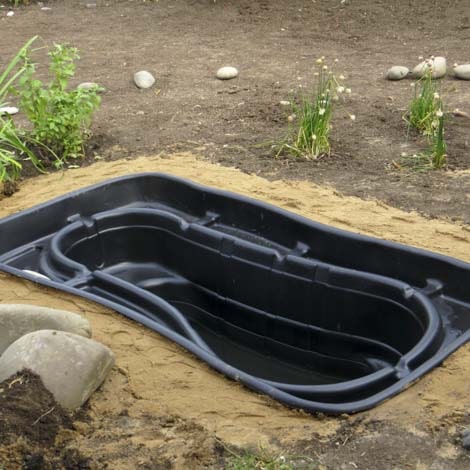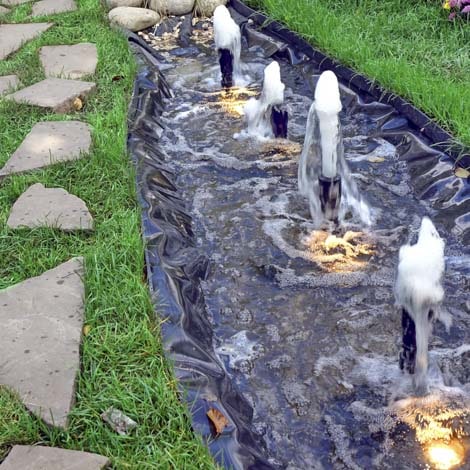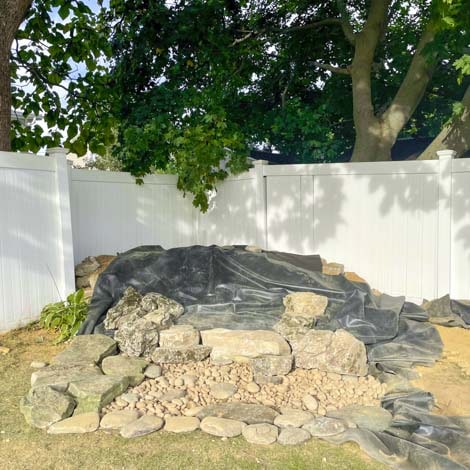Pond liners are an important part of many backyard water features. While natural-bottom ponds are an option, liners have certain benefits that make them an attractive choice for pond owners. But with all the different types of pond liners out there, how do you know which is right for you?
In this guide, we will go over some of the reasons to use a pond liner. We will also discuss the types of liners that are available and the styles of ponds they are best suited for. Click on a link below to jump to a specific section, or read on for the full story.
- Benefits of Pond Liners
- Types of Pond Liners
- What Pond Liner Should You Use?
- Large Pond Liners
- Next Steps
Benefits of Pond Liners
The most significant benefit of using a pond liner is water retention. Without a liner for pond water, you will need to refill your reservoir much more often. Water from your pond will be absorbed into the ground, especially if you’re in an area that is prone to drought or going through a heat wave.
Another benefit of pond liners is that they provide a clean starting point for your pond, one where the soil at the bottom of the pond is not mixed with your water.
Types of Pond Liners
- Rigid preformed plastic pond liner. These entry-level liners come in pre-molded shapes and sizes. These liners are fish-safe, fairly easy to install, not very large, and economical. You will need to create your water feature around the dimensions of the preformed pond liner, however, making them a less-than-ideal choice if you want flexibility in your design.
- EPDM pond liner. An EPDM rubber pond liner, such as this 45 Mil EPDM liner, is both durable and customizable. You can easily cut the liner to fit your pond’s precise shape and size, and the material is able to withstand a fair amount of wear and harsh weather conditions. More durability means less need for patch jobs down the line. EPDM is fish-safe, as well.
- PVC pond liner. An environment and budget-friendly option that can make for great small pond liners. PVC is a fish-safe material, and sections can be fused together, allowing for quick repairs when needed. This 40 Mil PVC liner comes in a variety of sizes and is long-lasting and weather resistent, making it a durable and cost-effective choice.
- Epoxy pond liner. Multi-surface epoxy liners, such as Pond Armor’s Pond Shield, are fish-safe, durable, and work well with smaller water features. Epoxy is a two-part product that requires mixing, careful application, and cure time. Pond Shield comes in a variety of colors and can stick to materials such as tile, rock, concrete, plastic, brick, fiberglass, or wood – note, however, that epoxy will not stick to a natural soil bottom.
What Pond Liner Should You Use?
The best type of pond liner to use depends on your budget as well as your unique pond or water feature. Each material has different advantages to consider.
Preformed plastic pond liners are easy to install but cannot be customized, making them suitable only for those with ponds that match the liner's dimensions. These liners are attractive to first-time pond builders. Many times, pond owners will install a preformed liner only to quickly upgrade to a higher-quality option they can customize.
EPDM liners are a natural choice for irregularly shaped ponds, given how easy the material is to cut and use. It is a favorite among pond builders and landscapers because EPDM liners are made of rubber that can easily bend, expand, and resist punctures. The liner is UV resistant and able to withstand sunlight and inclement weather. For these reasons, many people opt to use EPDM for a koi pond liner. And, while they have a higher upfront investment, EPDM liners require little maintenance and have long-lasting durability.
PVC, meanwhile, is ideal as a small-sized fish pond liner. You can fuse together multiple pieces, but it’s not quite as easy to cut as rubber, so you may want to use it in more traditionally shaped ponds. PVC liners are constructed from 100% post-consumer recycled PVC, offering an environmentally responsible and economical choice. While PVC liners are UV stable, any liner that is exposed to direct sunlight should be covered with dirt or stone. PVC liners can have a smaller upfront cost than EPDM and they are easy to repair, making them a solid choice for many pond owners.
A pond underlayment is recommended for both PVC and EPDM liners. Underlayments create a barrier between your liner and any rocks or debris. With a quality underlayment, your liner will be less susceptible to punctures and damage.
Epoxy liners are made of a flexible liquid material with excellent sheer tensile strength. Unlike EDPM and PVC liners which are a sheet of material, epoxy requires manual mixing and spreading, similar to a paint application. Epoxy is often used to seal concrete ponds, basins, and water features. It is a favorite for those converting a pool into a fish pond.
Large Pond Liners
Up until now, we have discussed liners that are best for small and medium-sized water gardens and koi ponds. For larger water features such as retention ponds, irrigation reservoirs, and farm ponds, there is The Pond Guy’s custom large pond liner. This liner is made from either 36 Mil or 45 Mil RPE, resulting in a heavy-duty liner built to last. Both pre-fabricated and custom-sized panels are available, as well, making large pond liners a versatile option that can fit just about any large water reservoir.
Next Steps
If you need help determining how much liner you need, head over to our Pond Liner Calculator. Our experts are also available to help if you have any additional questions.
Read More Related Articles
How to Build a Pond
Pond Liner Calculator & Guide
Add a Stream
Types of Ponds & Water Features
Last Updated: August 10, 2023


